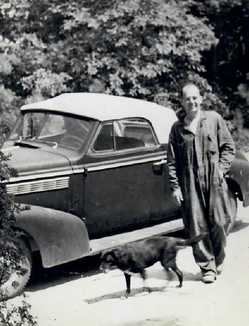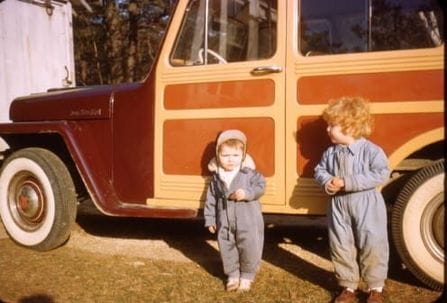* * * * * * * * * *
First, in the essay entitled “Out and About on the Jersey Shore,” dated May 3, 2016, I stated “Our friends the Evers had [a car with a rumble seat, a padded bench where the trunk should have been], and we all vied to be one of the two lucky ducks (three, if we wheedled persuasively enough) who got to ride there…. (The Evers family also had a Willy’s Jeep. They had all the good cars!)”
 (Courtesy of the Evers family)
(Courtesy of the Evers family) Thanks, Helen and Bill, for your generosity in sharing these wonderful old family photos. (I always have a hard time using the term "vintage" about photos of my own contemporaries!)
* * * * * * * * * *
A little clarification is in order. No, I don't remember my mother's ever owning or wearing white wool stockings. But I probably shouldn’t have used the term “bare-legged” (even though to my way of thinking it’s a distinction without a difference) because she was almost certainly wearing nylon stockings - and therein lies a story.
Nylon was developed in the 1930s in the lab of Wallace Carothers, a polymer scientist with Dupont, and patented in 1938. Although Dupont’s vision for their invention - the world’s first fully synthetic fiber - extended far beyond hosiery, they cannily decided to start by offering women an affordable and less delicate alternative to silk stockings. The new product was introduced with much hoopla at the New York World’s Fair in 1939 and went on sale to the general public in May of 1940. Four million pairs were sold on the first day alone. Nylon became a household word and “nylons” a synonym for stockings. They were more than just an article of women’s underwear, they offered hope that modern technology would lift a Depression-weary nation into prosperity once again.
Barely had nylons become one of life’s necessities for the American woman when they were snatched away. In December of 1941 the US entered World War II, and all nylon was diverted to the War effort, used for everything from parachutes to rope to aircraft fuel tanks. The only stockings to be had were bought either before the War or on the black market. To give the illusion they were wearing proper nylons, women painted “seams” down the backs of their legs (probably straighter than it was ever possible to get the real thing!). When stockings were reintroduced after the War, consumer demand outstripped supply, leading to mile-long queues and even “nylon riots,” with women getting into fist fights with one another in the heat of competition. Fortunately Dupont soon rose to the occasion and ramped up production of the coveted garment.
Late in the 1940s seamless nylons became available, but surprisingly they never entirely caught on. (For some, apparently the seams were part of the mystique.) Nylons, with or without seams, along with the garter belts that held them up, remained women’s wardrobe mainstays until the introduction of pantyhose in 1959 - ushering in a trend towards higher hemlines and ultimately the micro-miniskirts that shocked us all a few years later. But that is another story.
I should add that little girls did not wear nylons until they reached their teens or at least their tween years. In the firehouse Christmas party photo, the girls truly were bare-legged, though we usually wore leggings when we went outside during the winter. By leggings I don’t mean either the modified tights that are now called leggings or the leg-warmers worn by dancers and dancer wannabes, I’m talking about thick wooly pants held up with suspenders that were companion garments to winter coats. These leggings were only worn outside, so we put them on and took them off again multiple times per day - going to and from school, for recess, at lunchtime, etc. Synthetics had not yet revolutionized cold-weather gear, at least not for civilians, and we spent much of our outdoor recreation time looking and feeling like the Pillsbury Doughboy - unlike our moms, who simply had to grin and bear it.
Thanks, Julie, for asking a good question and for caring about how cold your grandmother must have been!


 RSS Feed
RSS Feed